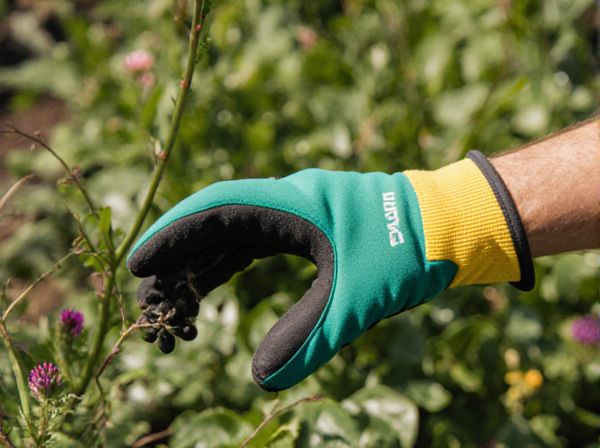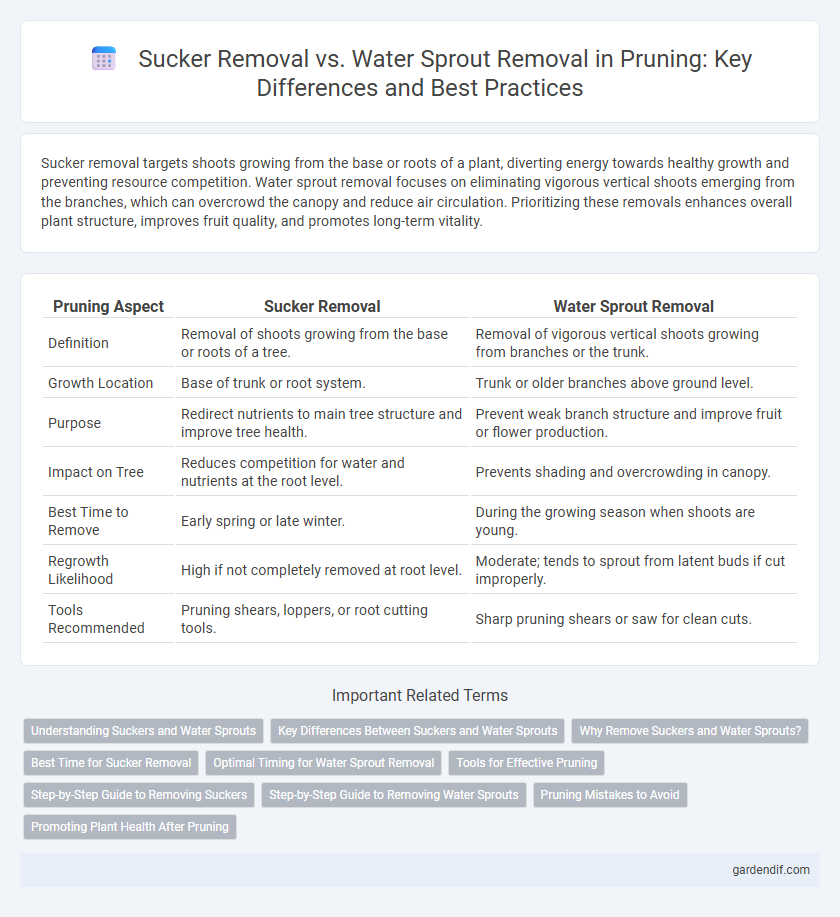
Sucker removal vs water sprout removal Illustration
Sucker removal targets shoots growing from the base or roots of a plant, diverting energy towards healthy growth and preventing resource competition. Water sprout removal focuses on eliminating vigorous vertical shoots emerging from the branches, which can overcrowd the canopy and reduce air circulation. Prioritizing these removals enhances overall plant structure, improves fruit quality, and promotes long-term vitality.
Table of Comparison
| Pruning Aspect | Sucker Removal | Water Sprout Removal |
|---|---|---|
| Definition | Removal of shoots growing from the base or roots of a tree. | Removal of vigorous vertical shoots growing from branches or the trunk. |
| Growth Location | Base of trunk or root system. | Trunk or older branches above ground level. |
| Purpose | Redirect nutrients to main tree structure and improve tree health. | Prevent weak branch structure and improve fruit or flower production. |
| Impact on Tree | Reduces competition for water and nutrients at the root level. | Prevents shading and overcrowding in canopy. |
| Best Time to Remove | Early spring or late winter. | During the growing season when shoots are young. |
| Regrowth Likelihood | High if not completely removed at root level. | Moderate; tends to sprout from latent buds if cut improperly. |
| Tools Recommended | Pruning shears, loppers, or root cutting tools. | Sharp pruning shears or saw for clean cuts. |
Understanding Suckers and Water Sprouts
Suckers are vigorous shoots emerging from the base or roots of a tree, often draining essential nutrients and weakening the overall plant health, whereas water sprouts grow vertically from the tree's branches or trunk, frequently resulting from stress or pruning cuts. Removing suckers is critical to maintain the tree's energy balance and prevent compromised growth, while water sprout removal targets improving air circulation and shaping the canopy to reduce disease risk. Effective management of both suckers and water sprouts enhances tree vigor, promotes fruit quality, and supports structural stability.
Key Differences Between Suckers and Water Sprouts
Suckers grow from the rootstock or base of the tree and are typically more vigorous with weak attachment, while water sprouts emerge from the main branches or trunk and grow vertically with dense foliage. Suckers divert nutrients from the main plant, potentially reducing fruit quality, whereas water sprouts can shade out productive branches and create a dense canopy that limits air circulation. Removing suckers helps maintain tree vigor and fruit quality, whereas water sprout removal promotes better light penetration and overall tree structure.
Why Remove Suckers and Water Sprouts?
Removing suckers and water sprouts is essential for maintaining tree health and improving fruit production. Suckers, which grow from the rootstock, divert nutrients away from the main tree, weakening its structure, while water sprouts emerge from branches and create dense, shading growth that reduces air circulation and light penetration. Eliminating these vigorous, non-fruiting shoots helps promote balanced growth, reduces disease risk, and enhances overall tree vigor.
Best Time for Sucker Removal
The best time for sucker removal is in early spring before active growth begins, allowing the tree to direct energy toward healthy branches and fruit production. Suckers grow from the rootstock and often appear at the base of the tree, competing for nutrients and water. Removing them promptly improves overall tree health and prevents undue stress during the growing season.
Optimal Timing for Water Sprout Removal
Optimal timing for water sprout removal is critical to prevent excessive shading and maintain tree vigor, with the best period usually in late winter to early spring before active growth begins. Removing water sprouts during this dormant phase minimizes sap loss and reduces the risk of infection. Timely pruning ensures better healing and redirects energy to healthy branches, enhancing overall canopy structure.
Tools for Effective Pruning
Effective pruning of suckers and water sprouts requires specialized tools such as bypass pruners, loppers, and pruning saws to ensure clean cuts that promote plant health. Bypass pruners are ideal for removing smaller suckers, while loppers and pruning saws handle thicker water sprouts efficiently. Utilizing sharp, sterilized tools minimizes damage and reduces the risk of disease transmission during sucker and water sprout removal.
Step-by-Step Guide to Removing Suckers
Start by identifying suckers, which are vigorous shoots emerging from the base or roots of the plant and often drain energy from the main growth. Use clean, sharp pruning shears to cut suckers as close to their origin as possible, ensuring not to damage the main stem or trunk. Regularly monitor for new sucker growth to maintain plant health and direct resources to desired branches.
Step-by-Step Guide to Removing Water Sprouts
Begin by identifying water sprouts, which are vigorous vertical shoots emerging from branches or trunks, differing from suckers that grow from the base. Use sharp, clean pruning shears to cut water sprouts at their point of origin, removing them flush with the branch or trunk to prevent regrowth. Regularly inspect the tree during the growing season to promptly remove new water sprouts, promoting healthier branch structure and improved air circulation.
Pruning Mistakes to Avoid
Sucker removal and water sprout removal are essential pruning tasks often confused, yet they serve different purposes to maintain tree health. Removing suckers--vigorous shoots arising from the rootstock--prevents nutrient diversion, while water sprouts--fast-growing shoots on branches--can weaken structure if left unchecked. Mistakes to avoid include cutting too close to the trunk, which can damage tissues, or removing all water sprouts at once, hindering the tree's natural defense and growth balance.
Promoting Plant Health After Pruning
Sucker removal targets vigorous, unproductive shoots emerging from the base or roots, preventing energy diversion and reducing disease risk, while water sprout removal focuses on fast-growing, weak shoots from branches that can create dense, shaded areas promoting fungal infections. Effective pruning by selectively removing suckers and water sprouts enhances air circulation and sunlight penetration, critical factors for promoting plant health and vigorous growth after pruning. Regular monitoring and precise cutting at the right time further support recovery, stress reduction, and long-term vitality of trees and shrubs.
Sucker removal vs water sprout removal Infographic

 gardendif.com
gardendif.com